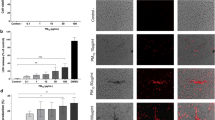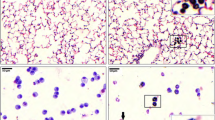Abstract
Increased levels of particulate air pollution (PM10) have been implicated as a causal agent in pulmonary disease exacerbation and increased deaths from respiratory and cardiovascular disorders. The exact mechanism by which PM10 drives toxicity in the lung is still unknown, but studies have focused on inhibition of macrophage function and impaired alveolar clearance mechanisms. To assess the effects of PM10 on pulmonary macrophage clearance mechanisms ex vivo, Wistar rats were instilled with 125 or 250 μg of PM10 collected from the North Kensington, London. Control rats were instilled with sterile saline. The rats were sacrificed after 18 h and a bronchoalveolar lavage (BAL) was performed. Macrophages isolated from the BAL fluid were assessed for ability to migrate towards a positive chemoattractant (ZAS) ex vivo and to perform phagocytosis. Macrophages isolated from the PM10-exposed rats showed inhibition of potential to migrate. Macrophage phagocytic ability ex vivo was also significantly reduced by the presence of PM10 inside the cells. This study indicates that acute PM10 exposure diminishes macrophage motility and phagocytosis in a manner that could prove deleterious to particle clearance from the alveolar region of the lung. Decreased particle clearance promotes inflammation, and hence, warrants further investigation in relation to the effects of chronic PM10 exposure on macrophage clearance mechanisms and establishing the mechanisms behind decreased macrophage migration.




Similar content being viewed by others
Abbreviations
- BAL:
-
bronchoalveolar lavage
- BSA:
-
bovine serum albumin
- C5a:
-
complement protein C5a
- CAPS:
-
concentrated ambient particles
- ELISA:
-
enzyme-linked immunosorbent assay
- GSH:
-
glutathione
- HCl:
-
hydrochloric acid
- LDH:
-
lactate dehydrogenase
- MCE:
-
mucociliary escalator
- MIP-2:
-
macrophage inflammatory protein 2
- NADH:
-
nicotinamide adenine dinucleotide (reduced)
- PBS:
-
phosphate-buffered saline
- PM:
-
particulate matter
- PM10:
-
particulate air pollution with a diameter ≤ 10 μm
- S-HRP:
-
streptavidin–horse radish peroxidase
- TiO2:
-
titanium dioxide
- TMB:
-
tetramethylbenzidine
- TNFα:
-
tumour necrosis factor alpha
- ZAS:
-
zymosan-activated serum
References
Barlow PG, Donaldson K, MacCallum J, Clouter A, Stone V. Serum exposed to nanoparticle carbon black displays increased potential to induce macrophage migration. Toxicol Lett 2005a;155(3):397–401.
Barlow PG, Clouter-Baker A, Donaldson K, MacCallum J, Stone V. Carbon black nanoparticles induce type II cells to release chemotaxins for alveolar macrophages. Part Fibre Toxicol 2005b;2:11.
Brown DM, Wilson MR, MacNee W, Stone V, Donaldson K. Size dependent proinflammatory effects of ultrafine polystyrene particles: a role for surface area and oxidative stress in the enhanced activity of ultrafines. Toxicol Appl Pharmacol 2001;175(3):191–9.
Brown DM, Donaldson K, Stone V. Effects of PM10 in human peripheral blood monocytes and J774 macrophages. Respir Res 2004;21:5–29.
Dellinger B, Pryor WA, Cueto R, Squadrito GL, Hedge V, Deutsch WA. Role of free radicals in the toxicity of airborne fine particulate matter. Chem Res Toxicol 2001;14(10):1371–7.
Dockery DW, Pope CA III. Acute respiratory effects of particulate air pollution. Annu Rev Public Health 1994;15:107–32.
Donaldson K, MacNee W. Potential mechanisms of adverse pulmonary and cardiovascular effects of particulate air pollution (PM10). Int J Hyg Environ Health 2001;203(5–6):411–5.
Donaldson K, Slight J, Bolton RE. The effect of products from bronchoalveolar-derived neutrophils on oxidant production and phagocytic activity of alveolar macrophages. Clin Exp Immunol 1988;74(3):477–82.
Donaldson K, Slight J, Brown DM. Effects of products from inflammatory pulmonary neutrophils on alveolar macrophage chemotaxis, spreading and thymidine incorporation. Inflammation 1989;13(4):443–53.
Donaldson K, Brown GM, Brown DM, Slight J, Robertson MD, Davis JM. Impaired chemotactic responses of bronchoalveolar leukocytes in experimental pneumoconiosis. J Pathol 1990;160(1):63–9.
Donaldson K, Brown DM, Mitchell C, Dineva M, Beswick PH, Gilmour P, et al. Free radical activity of PM10: iron-mediated generation of hydroxyl radicals. Environ Health Perspect 1997;105(Suppl. 5):1285–9.
Driscoll KE. TNF alpha and MIP-2: role in particle-induced inflammation and regulation by oxidative stress. Toxicol Lett 2000;112–113:177–84.
Duffin R, Gilmour PS, Schins RPF, Clouter A, Guy K, Brown DM, et al. Aluminium lactate treatment of DQ12 quartz inhibits its ability to cause inflammation, chemokine expression and nuclear factor-êB activation. Toxicol Appl Pharmacol 2001;176(1):10–7.
Ghio AJ, Devlin RB. Inflammatory lung injury after bronchial instillation of air pollution particles. Am J Respir Crit Care Med 2001;164(4):704–8.
Gilmour PS, Brown DM, Lindsay TG, Beswick PH, MacNee W, Donaldson K. Adverse health effects of PM10 particles: involvement of iron in generation of hydroxyl radicals. Occup Environ Med 1996;53(12):817–22.
Hoet PH, Nemery B. Stimulation of phagocytosis by ultrafine particles. Toxicol Appl Pharmacol 2001;176(3):203.
Holgate ST, Devlin RB, Wilson SJ, Frew AJ. Health effects of acute exposure to air pollution. Part II: Healthy subject exposed to concentrated ambient particles. Res Rep Health 2003;112:31–50.
Hutchison GR, Brown DM, Hibbs LR, Heal MR, Donaldson K, Maynard RL, et al. The effect of refurbishing a UK steel plant on PM10 metal composition and ability to induce inflammation. Respir Res 2005;6(1):43.
Jimenez LA, Drost EM, Gilmour PS, Rahman I, Antonicelli F, Ritchie H, et al. PM10-exposed macrophages stimulate a proinflammatory response in lung epithelial cells via TNF-alpha. Am J Physiol Lung Cell Mol Physiol 2002;282(2):L237–48.
Lehnert BE, Morrow PE. Characteristics of alveolar macrophages following the deposition of a low burden of iron oxide in the lung. J Toxicol Environ Health 1985;16(6):855–68.
Li XY, Gilmour PS, Donaldson K, MacNee W. Free radical activity and proinflammatory effects of particulate air pollution (PM10) in vivo and in vitro. Thorax 1996;51(12):1216–22.
Lightbody J, Hutchison G, Donaldson K, Stone V. The influence of particle composition and size on in vitro and in vivo biological models. Report to the UK National Air Quality Archive and DEFRA. June 2003; EPG 1/3/147. http://www.airquality.co.uk).
Möller W, Hofer T, Ziesenis A, Karg E, Heyder J. Ultrafine particles cause cytoskeletal dysfunctions in macrophages. Toxicol Appl Pharmacol 2002;182(3):197–207.
Monn C, Fendt R, Koller T. Ambient PM10 extracts inhibit phagocytosis of defined inert model particulates by alveolar macrophages. Inhal Toxicol 2002;14(4):369–85.
Morrow PE. Possible mechanisms to explain dust overloading of the lungs. Fundam Appl Toxicol 1988;10(3):369–84.
Oberdörster G. Lung particle overload: implications for occupational exposures to particles. Regul Toxicol Pharmacol 1995;21(1):123–35.
Oberdörster G, Ferin J, Lehnert BE. Correlation between particle size, in vivo particle persistence and lung injury. Environ Health Perspect 1994;102(Suppl 5):173–9.
Obot CJ, Morandi MT, Beebe TP, Hamilton RF, Holian A. Surface components of airborne particulate matter induce macrophage apoptosis through scavenger receptors. Toxicol Appl Pharmacol 2002;184(2):98–106.
Pope CA III, Bates DV, Raizenne ME. Health effects of particulate air pollution: time for reassessment? Environ Health Perspect 1995;103(5):472–80.
Renwick LC, Donaldson K, Clouter A. Impairment of alveolar macrophage phagocytosis by ultrafine particles. Toxicol Appl Pharmacol 2001;179(2):119–27.
Renwick LC, Brown D, Clouter A, Donaldson K. Increased inflammation and altered macrophage chemotactic responses caused by two ultrafine particle types. Occup Environ Med 2004;61(5):442–7.
Rhoden CR, Lawrence J, Godleski JJ, Gonzalez-Flecha B. N-acetylcysteine prevents lung inflammation after short-term inhalation exposure to concentrated ambient particles. Toxicol Sci 2004;79(2):296–303.
Roberts ES, Richards JH, Jaskot R, Dreher KL. Oxidative stress mediates air pollution particle-induced lung injury and molecular pathology. Inhal Toxicol 2003;15(13):1327–46.
Schins RP, Lightbody JH, Borm PJ, Shi T, Donaldson K, Stone V. Inflammatory effects of coarse and fine particulate matter in relation to chemical and biological constituents. Toxicol Appl Pharmacol 2004;195(1):1–11.
Seaton A, MacNee W, Donaldson K, Godden D. Particulate air pollution and acute health effects. Lancet 1995;345(8943):176–8.
Shoemaker DA, Pretty JR, Ramsey DM, McLaurin JL, Khan A, Teass AW, et al. Particle activity and in vivo pulmonary response to freshly milled and aged alpha-quartz. Scand J Work Environ Health 1995;21(Suppl 2):15–8
Squadrito GL, Cueto R, Dellinger B, Pryor WA. Quinoid redox cycling as a mechanism for sustained free radical generation by inhaled airborne particulate matter. Free Radic Biol Med 2001;1.31(9):1132–8.
Stone V, Shaw J, Brown DM, MacNee W, Faux SP, Donaldson K. The role of oxidative stress in the prolonged inhibitory effect of ultrafine carbon black on epithelial cell function. Toxicol In Vitro 1998;12:649–59.
Stone V, Wilson MR, Lightbody JH, Donaldson K. Investigating the potential for interaction between the components of PM10. Environ Health Prev Med 2003;7(6):246–53.
Tran CL, Buchanan D, Cullen RT, Searl A, Jones AD, Donaldson K. Inhalation of poorly soluble particles II. Influence of particle surface area on inflammation and clearance. Inhal Toxicol 2000;12(12):1113–26.
Acknowledgements
The authors would like to acknowledge Napier University, Edinburgh for the funding of this project. PGB would like to acknowledge the experimental assistance of Dr. Gary Hutchison.
Conflict of Interest Statement
None of the authors of this manuscript have any conflicts of interest to declare.
Author information
Authors and Affiliations
Corresponding author
Rights and permissions
About this article
Cite this article
Barlow, P.G., Brown, D.M., Donaldson, K. et al. Reduced alveolar macrophage migration induced by acute ambient particle (PM10) exposure. Cell Biol Toxicol 24, 243–252 (2008). https://doi.org/10.1007/s10565-007-9033-y
Received:
Accepted:
Published:
Issue Date:
DOI: https://doi.org/10.1007/s10565-007-9033-y




